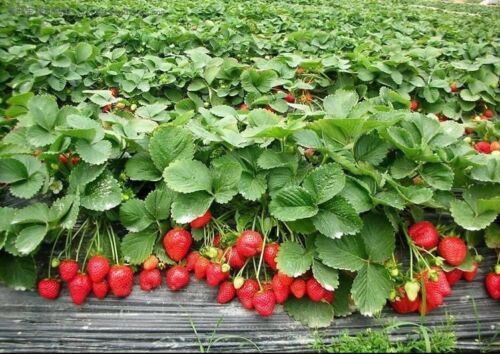*NEW* STRAWBERRY * GIANT* , LARGEST FRUIT , EVERBEARING 105 SEEDS
$3.95 (-40%)
Description
Grown , processed, & packaged right on our farm . VERY EASY to grow . Our ” LARGE FRUIT” variety seed will produce for 3 years or more giving you BASKET BUSTING yields . EVERBEARING , will produce berries thru summer till frost . Heavy straw mulch during winter months, a germination track record of over 80 % . Each packet has a minimum of 105 seeds . Germinating & planting instructions included . You are buying 105 SEEDS . 105 plants can produce as much as 105 gallons of fruit per season , thats $2000 dollars worth of fruit retail ! Thanks for looking .
Starting
Germination is the trickiest aspect to growing strawberries. Be patient, and try the tricks below.
Tuck your strawberry seed packet inside a sealed plastic bag or airtight container and place in your freezer for 3-4 weeks. When you remove the bag or container, do not break the seal until it (and its living contents) have reached room temperature. This may take several hours. Err on the side of caution. Opening the package too quickly may result in water condensing on the cold seeds, and this will reduce your chances of success.
Once the sealed package has “thawed” to room temperature, you’re ready to plant. Sow the seeds on the surface of pre-moistened, sterilized seed starting mix in trays or small containers. Place these on a piece of felt or other thick cloth that has its end sitting in water. The idea is to wick up water from below so that the seedling medium stays constantly and evenly damp until germination.
Keep your seeded trays under bright fluorescent lights at a constant temperature of 18-24°C (65-75°F). Germination may take anywhere from 7 days to 6 weeks. Be patient. Once germination occurs, increase ventilation around your plants to prevent damping off.
Once your seedlings have their third true leaf, they can be transplanted into their own pots. Be sure to harden your seedlings off carefully and gradually before transplanting outside.
Growing
Space transplants 60cm (24″) apart in rows 90-120cm (36-48″) apart. Everbearing varieties (such as ours) tend to produce fewer runners, and will produce more fruit if the runners are removed. In the first year of growth, it may be preferable to encourage runners, and let them fill in the spaces between transplants with new offspring plants.
Grow strawberries in a well-drained, sandy loam that has been generously dug with organic matter such as finished compost or well-rotted manure. Dig ¼ cup complete organic fertilizer into the soil beneath each transplant. Keep soil moist, but not soggy. A mulch of straw around plants may help prevent the soil from drying out.
Companion Planting
These little plants respond strongly to nearby plants. Couple them with beans, borage, garlic, lettuce, onions, peas, spinach, and thyme. Avoid Brassicas and fennel.
Planting the Strawberry Seeds Indoors # 2
1.
Fill a cup, jar or other container with soil suitable for growing strawberries.
2.
Dip the toothpick in water. It should be damp, not dripping wet. Take the tip of the toothpick and poke a couple of your seeds, they should stick onto the toothpick without falling off.
3.
Once about five to seven seeds have stuck to the toothpick, hold the toothpick over the soil-filled cup. Flick the top of the toothpick (not the seeds) with your middle or forefinger. The strawberry seeds should fall off and scatter into the cup.
4.
Repeat several times until all of the seeds are in the soil-filled cup (or container).
Helping the Seeds to Grow
1.
Fill a cup of water a third of the way. Add two thirds hydrogen peroxide.
2.
Stir the mixture. Dip the toothpick in this solution. Then drip some of the solution over the seeds. This will help them grow, as hydrogen peroxide is a natural oxidizer.
Note: You do not need to do this every day––every other day is fine until the seeds have sprouted, then once a week is all you need.
3.
Water the soil gently. Don’t overdo the watering or the seeds will drown and can turn moldy. Keep the soil moist but not wet, watering about once or twice a week.
4.
Place the jar in a warm place where there is enough sunlight for the seeds to sprout.
5.
Wait until the seeds sprout. In 2-4 weeks, the seeds should have sprouted. If enough plants take, you can transplant them after a few weeks, into separate pots.
6.
Keep tending to the strawberries. When the plants grow large enough, fruit will form and the plant should be sprouting some yummy strawberries for you to eat.







